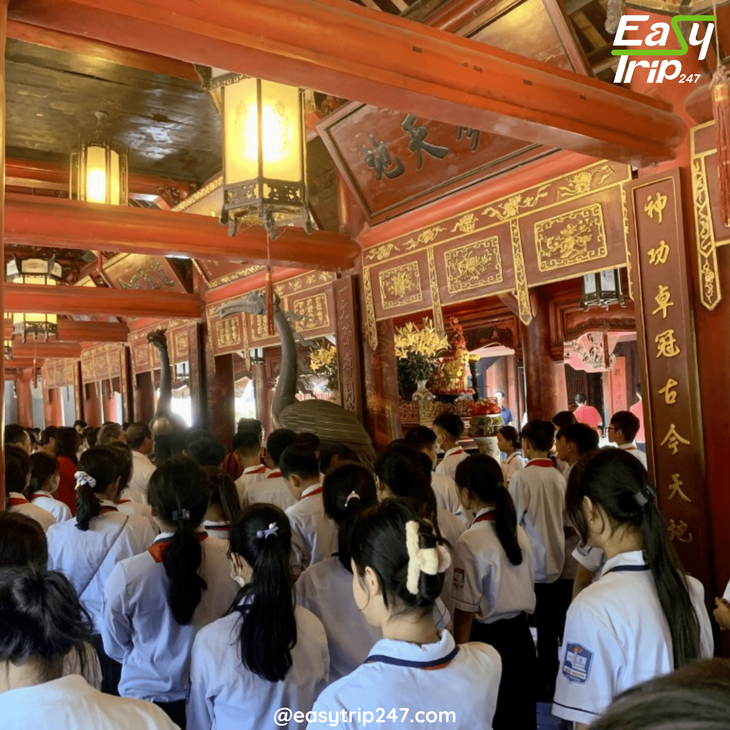
Vietnam, a country rich in both history and spirituality, is home to numerous sacred sites that cater to people of all faiths. From the towering Buddhist pagodas nestled in the mountains to the quiet Catholic shrines tucked away in the countryside, Vietnam offers an "Easy Trip" for religious pilgrims of all kinds. With a bit of thoughtful planning and an understanding of what to expect, you can have a fulfilling pilgrimage that’s both spiritually rewarding and logistically stress-free.
1. Choosing the Right Religious Sites for Your Pilgrimage in Vietnam
When embarking on a religious pilgrimage in Vietnam, one of the first steps in ensuring an "Easy Trip" is deciding on the specific sites you wish to visit. Vietnam is home to a variety of religious landmarks that attract pilgrims from around the world. The country’s predominant religions—Buddhism, Catholicism, and indigenous practices—are represented in the many sacred sites scattered throughout the country.
Buddhism is particularly significant in Vietnam, and many religious pilgrims choose to visit the iconic Yen Tu Mountain, located in the northern part of the country. Known as the birthplace of the Truc Lam Zen Buddhist sect, Yen Tu offers a breathtaking journey through lush forests and serene landscapes, culminating in a visit to the stunning Dong Pagoda at the mountain’s peak. A visit to Yen Tu provides not just a religious experience, but also an opportunity to connect deeply with nature, allowing for spiritual reflection while surrounded by tranquil beauty.
In central Vietnam, La Vang Sanctuary serves as an essential pilgrimage site for Catholics. La Vang is considered the site of the miraculous appearance of the Virgin Mary in the late 18th century, making it a powerful destination for prayer and devotion. Pilgrims visit the sanctuary to light candles, offer prayers, and seek blessings for health, prosperity, and peace. The surrounding lush forests add to the sanctuary’s spiritual atmosphere, making it an ideal location for quiet reflection during your "Easy Trip" pilgrimage.
For those looking to combine spiritual reflection with natural beauty, Trang An and the nearby Bai Dinh Pagoda in Ninh Binh offer a unique blend of both. Known as the "Halong Bay on land," Trang An’s breathtaking scenery of limestone karsts and caves provides a peaceful backdrop for spiritual practices, while Bai Dinh Pagoda is one of the largest Buddhist complexes in Southeast Asia. Visitors to the pagoda can participate in ceremonies, offer incense, and enjoy the serene ambiance of the surrounding mountains and rivers. These destinations offer an "Easy Trip" for those seeking both beauty and spirituality in one location.
2. The Best Time for an Easy Trip Pilgrimage in Vietnam
Choosing the right time to embark on your religious pilgrimage is crucial for ensuring an "Easy Trip." Vietnam’s climate can vary greatly depending on the region and the time of year, so it’s important to consider the best season for travel. For the northern and central regions, the best months for a pilgrimage are from October to April when the weather is cooler and more pleasant. The rainy season, which lasts from May to September, can make travel difficult and uncomfortable, especially in mountainous or rural areas.
If you're planning to visit places like Yen Tu Mountain or Bai Dinh Pagoda, it's recommended to go during the dry season to avoid trekking in the rain or navigating slippery paths. The weather is typically cooler and more comfortable, providing a better environment for spiritual reflection and hiking to higher altitudes. During these months, you can also avoid the heavy crowds that tend to gather at pilgrimage sites during public holidays or religious festivals.
In southern Vietnam, particularly in the Mekong Delta area, the weather remains relatively consistent year-round, but the dry season (from November to April) is still the most comfortable for travel. If your pilgrimage involves visiting Catholic shrines like the Vinh Trang Pagoda, this is the ideal time for a peaceful and undisturbed experience.
3. Transportation Tips for an Easy Trip Pilgrimage
Vietnam’s infrastructure is well-developed, and getting around for religious pilgrimages is generally straightforward. For an "Easy Trip," it's a good idea to familiarize yourself with the different transportation options available to ensure a smooth journey to your religious destinations.
For pilgrimage sites in urban areas or along the coast, such as Ho Chi Minh City or Hanoi, public transport options like buses, taxis, and ride-hailing apps like Grab are widely available and affordable. However, for rural or remote destinations, like Yen Tu or La Vang, it’s advisable to hire a private car or book a guided tour to ensure a comfortable and efficient trip. Renting a car with a local driver allows for flexibility and convenience, especially if you're visiting multiple pilgrimage sites.
Many pilgrims choose to take domestic flights for long-distance travel within Vietnam. The country's major cities, such as Hanoi, Ho Chi Minh City, and Da Nang, are well-connected by air. From these cities, you can take a short flight to regional hubs close to religious destinations, reducing travel time and allowing for a more relaxed experience.
For those seeking a more immersive "Easy Trip," consider using Vietnam’s extensive bus system. While it might take longer, buses offer an affordable and scenic way to travel between cities and smaller towns. If you're traveling by bus, book tickets in advance to secure your seat, especially during busy seasons or religious festivals.
4. Accommodation for Pilgrims: Finding Peaceful Retreats
Accommodation is a key aspect of ensuring your "Easy Trip" is truly restful. Many of Vietnam’s religious pilgrimage sites offer nearby accommodations that cater to pilgrims seeking tranquility. For example, Yen Tu Mountain and Bai Dinh Pagoda have nearby hotels and guesthouses that provide a peaceful environment for rest and reflection after a day of prayer and meditation.
In some places, like Trang An and the Mekong Delta, eco-friendly retreats and homestays offer unique accommodations that allow you to connect with local culture while being close to nature. These options provide simple yet comfortable lodging, often in serene surroundings that enhance the spiritual atmosphere of your pilgrimage.
For more luxurious options, Vietnam’s major cities offer a wide range of hotels and resorts that are easily accessible by public transportation or private vehicles. Look for hotels that are centrally located, so you can easily access your religious sites without long journeys. When booking, prioritize accommodations that offer peaceful atmospheres, away from the bustle of the city, to help enhance your spiritual experience during your "Easy Trip."
5. Cultural Etiquette and Respecting Local Customs
When embarking on a religious pilgrimage, one of the most important things to remember is cultural etiquette. Vietnam is a country rich in traditions and customs, and it’s essential to respect local practices, especially in religious sites. When visiting Buddhist temples, pagodas, or Catholic shrines, it’s customary to dress modestly, covering your shoulders and legs. This is particularly important when visiting sacred spaces, as it shows respect for the local culture and the religious significance of the site.
In some places, it’s customary to remove your shoes before entering temples or homes. Always observe the behavior of locals or other pilgrims, as this can guide you in following the appropriate customs. Additionally, silence is often observed in religious spaces to maintain the peaceful atmosphere, so be mindful of your surroundings and avoid loud conversations.
If you’re uncertain about any local customs, don’t hesitate to ask your guide or other pilgrims for guidance. Vietnamese people are generally welcoming and appreciate visitors who show respect for their culture and traditions.
6. Making the Most of Your Easy Trip Pilgrimage Experience
To ensure your religious pilgrimage is both meaningful and comfortable, plan ahead by considering the activities you want to engage in. Many religious sites offer additional experiences, such as guided tours, meditation sessions, or spiritual talks. Participating in these activities can enrich your understanding of the site’s history and significance, as well as deepen your personal connection to your pilgrimage.
Before heading to each site, take time to reflect on what you hope to achieve spiritually. Are you looking for moments of deep reflection, or are you seeking to learn more about the history of the religion? Having a clear intention will help you focus your journey and make the most of your "Easy Trip."
Conclusion
Planning a religious pilgrimage in Vietnam is an exciting and spiritually fulfilling experience. By considering transportation, accommodation, timing, and cultural practices, you can ensure an "Easy Trip" that allows you to connect deeply with your faith while enjoying the serene beauty of the country’s most sacred sites. Vietnam offers a rich tapestry of religious and cultural destinations, each providing a unique and meaningful experience for pilgrims. Whether you’re visiting the Buddhist mountains of Yen Tu, the Catholic shrines of La Vang, or the tranquil pagodas of Ninh Binh, Vietnam offers an accessible and enriching journey for all religious travelers. Through careful planning and thoughtful travel, your pilgrimage can be a seamless and transformative experience.
Design Your Tour Today And Get A Quote. Contact Us Here: +84.975.504.825
Source: Easytrip247 Team compiled.
